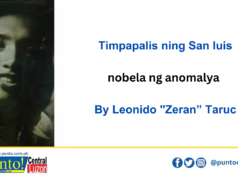PETMALU. LODI. Werpa. Current buzzwords of millennials who have arrogated unto themselves the crafting of some argot peculiar to their generation.
Sorry to disappoint but there is nothing new in this practice of reading/speaking words in reverse. Tombalibanta or baligtaran it was called when I was growing up, with those same terms – I learned at the cusp of adulthood – applying to some sexual position best known by its representative number.
Curiosity picked, this recurrence of an old practice taken as a phenomenon by millennials drove me to look for the linguistic genre under which it is classified.
The nearest I came to is emordnilap – “a word that can be read diff erently in reverse – it is read one way forward and another way backwards.” “Reverse pair,” it’s also called. As in sleep-peels, pay-yap, stressed-desserts, pans-snap. Even in the name Leon-Noel.
Concededly, the way it’s done here is not in the emordilap’s strictest sense, with the reversing going beyond the letters and into syllables, the form from print to phonetics. Still, the sense of the word obtains, if loosely.
Anyways, emordnilap is itself the reverse of palindrome which refers to a word or phrase, or even a sentence that reads the same forward as backward.
Palindrome is exampled in words as radar, level, racecar, madam; in the phrase “a man, a plan, a canal, Panama”; in the sentence “Able was I, I saw Elba.” Got the drift?
Really now, what is novel or millennially exclusive to emordnilap hereabouts?
Why, in 19th century Las Islas Filipinas there was Plaridel, the nom de plume of the great propagandist Marcelo H. del Pilar.
As far back as my boyhood days in somnolent Sto. Tomas town, reverse pair was already widely practised. There was a lifelong bachelor better known as Quinwazonti than his real name of Joaquin Tizon. And an uncle – Mironggasbatang – from his other moniker Roming Tanggas.
The barrio drunkard went by the tag Syonga Tongsiok reversed from Asyong Sioktong.
Not even persons with disabilities were spared. Anyone with a cleft lip was called ebung from the vernacular bunge. And those suffering from strabismus – the cross-eyed, that is – lengdu. The blind? Lagbu. The lame? Kulti.
For the gullible, it was alalum, backwards of mulala.
The hydrophobic sans rabies, dehin goli.
Among the celluloid stars of the era were the Sky-Flakes-faced Ciagar Nobi (Bino Garcia), the archvillain Topakits (Paquito Diaz), the comedians Tochiqui and Pidol, and of course, the tough guy who would be president Erap (a reverse of pare).
So inured was I to names and things said in reverse that I impressed my high school literature teacher with my readily reading rightly the meaning of the title of the Samuel Butler classic, Erewhon.
Then came too the parental terms of endearment ermat and erpat. From whom we got our allowance for the day, the usual etneb, from beynte (20) that is sopi in college, raised from the mosenti, in grade school.
Hard-up economically, the family could not afford a domestic longkatuts being most of the time alaws atik.
With the sexual mores of the day, it did not take too much imagination to read the meanings of bogli, etits, keps and ratbu, to cite the least vulgar rendition of prurience.
In college, the rich boy with the fl ashy tsekot usually got the materialistic damags (reversed contraction of maganda) among the coeds. Now, perfect emordnilap at the UP-Diliman jeepney routes of ikot-toki.
It was at the state university that conscientization turned me into a tibak who, when protest demonstrations became violent, had to make botak from truncheon-wielding lespu. A word: tibak in this sense is reversed aktib(ista). Not kabit for mistress which is betka.
The Bohemian dream in my teens birthed my pe-hips days of modams – that’s for hippies, and grass of the hallucinating kind, dummy.
One who did not outgrow those wild flower power days was the rocker Sampaguita who, into the late ‘90s, still rolled and rocked Nosibalasi.
Hip into his ‘80s, though defi nitely never the hippie, was the late San Fernando business patriarch and provincial board member Ceferino Laus, meriting a mention here if only for the vanity plate of his car GNONIP, his nickname in reverse.
Fondly remembered as contemporaries of Apung Pinong in local politics of the ‘90s is the Mexico toughie monikered astig, naturally, and the San Fernando tightwad derided publicly as natmaku.
Political incorrectness is to call the aesthetically challenged ngetpa, which ironically turned into a weapon of mass mobilization that won three terms for that now dearly lamented Apalit mayor.
And then there’s tongpats, the single term that encompasses all graft and corruption in government, from the Bureau of Customs to the DPWH and everywhere else.
It can really be as stupid as it gets, not only in politics but in all aspects of life. Hence, the universality of ogag. Proved beyond doubt by that hit eponymous local television series at the onset of the early 21st century.
Perhaps, the precursor of things idiotical, rather than intellectual, that have come to those born around the new millennium. But that’s another tokwents.




